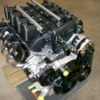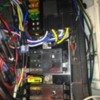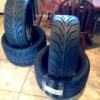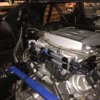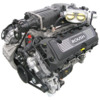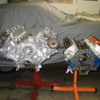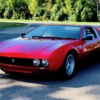
So after a few weeks of troubleshooting, with tons of measuring and CAD drawings, we figured out what the issue was with the clutch.
We were completely off with the thought that the throw of the bearing was the issue. Our clutch only requires .375 in of throw to disengage, and we had well over .700 in of throw. After we figured that out, it was back to the drawing board to find the issue. We spent lots of time measuring the clutch and the transmission and drew both in CAD to see if we could diagnose the issue on the computer. Sure enough, after enough analysis, we figured out that the stack height within the clutch was too tall, and was arranged in a way that the second clutch disk was too thick to be completely engaged on the spline, and was rubbing on the stepped edge of the spline causing the disk to be engaged even when the clutch was depressed all the way.
The solution: we called up SPEC and discussed with their tech support and they decided that they would build us a new set of clutch disks based on our CAD drawings that would engage the splines correctly. In about 5 days, we had a new set of clutch disks sitting on our front porch, and sure enough, once we got those re-installed in the transmission, they worked like a charm!
The reason we had this issue is because of the design of the dual-disk clutch for the LS9. It was designed for the ZR1 Corvette, obviously, and the Corvette is designed with the transmission in the rear of the car with a torque tube that spans the distance between the engine and the transaxle. Because of this, they do not have to deal with the clearance issues that come with a transaxle being bolted directly to the engine.
After we got that issue fixed, we decided to go for a drive in the car before finishing up the rest of the systems.

The car drove GREAT and wow does it have a lot of power. Unfortunately, the car started to feel a little bit less powerful after driving for about 20 minutes and then we got a check engine light. We figured that it probably had something to do with the intake air temperature since the intercooler is not yet functional. After we came back to the shop we plugged in our laptop and sure enough, we had two trouble codes, Intake Air Temperature Warning Level 1 and Intake Air Temperature Warning Level 2. As expected, the intake air was getting a bit too hot for comfort so the engine started to pull timing to protect itself and threw a check engine light and trouble code. Even with that little issue, boy was it nice to drive the car after over a year of hiatus.
When we got back it was time to get some of the other items on our to-do list finished. The first thing on that list was obviously the intercooler.
Our previous design for the intercooler connections was a bit convoluted due to the space constraints between the firewall and the engine. We came up with a great new design that looks WAY better.

We also got the intercooler lines from the back of the car to the front of the car. (Also, check out all of the lines that span the length of the car! We will be constructing some nice stainless steel splash shields to protect all of our lines.

Our last tasks include finishing the connections for the intercooler to the intercooler radiator at the front of the car, constructing a new exhaust system using the LS9 exhaust manifolds (temporary until we decide to go with 180 headers), finishing the air intake system, finish the roll bar installation, upholster various interior pieces including the engine hatch cover, etc.
We are so close to having a completely functional car. With the exception of some other miscellaneous tasks that we have after our last big tasks, the car is almost done! We are aiming to have all of our tasks completed over the next 30 days to give us ample time between then and our next track event to break-in the engine and work out any bugs. We will be out at Willow Springs this March so we can track test our new beast!
Check out some additional pics of some other things we got completed over the past two months including the installation of our new seats and roll bar


